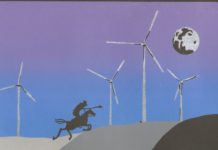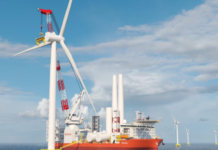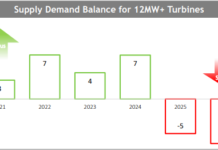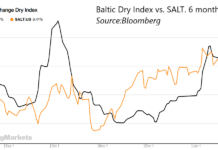James Montgomery
 Offshore Wind Farm photo via Bigstock. |
Preliminary rankings of global wind installation capacity show something not seen in 12 years: longtime market leader Vestas looking up at someone else.
BTM Consult, a division within Navigant’s Global Energy Practice, says General Electric (NYSE:GE) installed more wind turbine MW capacity than any other original equipment manufacturer (OEMs) in 2012. While not offering specific numbers, Aris Karcanias, senior analyst with BTM, acknowledged that it was “a clear win” for GE, and “not a difference of 50 megawatts),” though also “not a landslide.”
The full report isn’t due until late March, but here’s a quick look at BTM’s preliminary rankings:
- GE Wind: Was No. 3 in 2011. Three-quarters of its business is in the surging US market.
- Vestas (OTC:VWDRY): Was No.1 since 2000.
- Siemens (NYSE:SI): Moving up from ninth. Partly thanks to US exposure, partly to dominance in offshore wind.
- Enercon: Up one spot from fifth. Especially strong in its home market (Germany); also has good presence in markets outside the US and China.
- Suzlon Group (Bombay:SUZLON): Up one spot from sixth, thanks to its REPower subsidiary.
- Other top 10: Chinese OEMs Goldwind (was No. 2 in 2011), Guodian United Power, Sinovel (Shanghai:601558), and Mingyang (NYSE:MY) are in the top 10, but Sinovel is barely hanging onto that grouping. Gamesa (OTC:GCTAF), another former top-5 wind turbine OEM, is weighed down by reliance upon China and a FiT moratorium in its home Spanish market.
The change at the top of the rankings carries some importance because of Vestas’ longtime position of market leadership, particularly amid the past few years of turmoil. “Vestas has always been the one to catch,” points out Karcanias even while also being at the front of the pack in feeling growing pains following the financial crisis.
GE’s success can be attributed almost entirely to the robust US wind market, where roughly 13 gigawatts (GW) was installed in 2012 amid a mad rush to get wind projects completed ahead of the expiring production tax credit (PTC). As much as three-quarters of GE’s 2012 installed capacity was domestic, which boosted its business relative to its more international competitors, according to Karcanias.
Such reliance upon a single market is a double-edged sword. The PTC’s renewal could very well cause another rush in the US later this year, but even GE admits it likely will be nowhere near last year’s wind capacity surge. Many firms are awaiting clearer definition of “continual construction” as a key metric for PTC qualification; “there is very little spillover, very little construction at present,” he said. That means GE, despite making inroads into other markets e.g. Latin America, likely won’t have the same bump in business in 2013, while wind OEMs with a more distributed portfolio (Vestas, Siemens) might fare better. A 2013 return to the top for Vestas could very well happen, Karcanias said.
Other trends being gleaned from BTM’s forthcoming report:
– Policy uncertainty weighs down many key markets: the US, Europe (Spain, Italy, France, Portugal, the UK), and Asia (India, Australia, Japan). Even so, 2012 showed record global installations, with the U.S. and China accounting for 60 percent of the global market for wind power.
– Delayed payments from utilities to power producers in India (up to 14 months) and China (up to two years) are tightening cash flow throughout the wind turbine value chain.
– There’s a lack of transmission buildout, both land-based (China, Brazil, Mexico, Germany, US) and offshore (Germany). The big question: who’s ultimately responsible for the buildout is it a state-level or national regulatory issue? This won’t be answered quickly, and will cost a lot of money.
– Capacity factor improvements are pushing down wind’s levelized cost of energy (LCOE), but new shale gas extraction methods are lowering the bar for natural gas too, so the generation cost comparison for wind power isn’t as compelling. Karcanias suggests grid parity for wind might occur around 2017, but offshore wind is “still a long way from being cost-competitive.”Jim Montgomery is Associate Editor for RenewableEnergyWorld.com, covering the solar and wind beats. He previously was news editor for Solid State Technology and Photovoltaics World, and has covered semiconductor manufacturing and related industries, renewable energy and industrial lasers since 2003. His work has earned both internal awards and an Azbee Award from the American Society of Business Press Editors. Jim has 15 years of experience in producing websites and e-Newsletters in various technology.
This article was first published on RenewableEnergyWorld.com, and is reprinted with permission.







